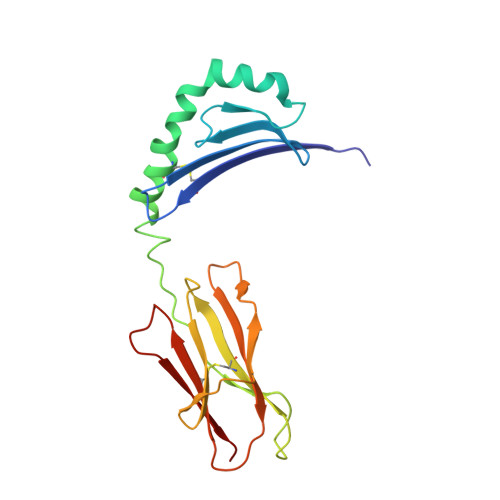1F3J
HISTOCOMPATIBILITY ANTIGEN I-AG7
- PDB DOI: https://doi.org/10.2210/pdb1F3J/pdb
- Classification: IMMUNE SYSTEM
- Organism(s): Mus musculus, Gallus gallus
- Expression System: Spodoptera frugiperda
- Mutation(s): No
- Deposited: 2000-06-04 Released: 2000-09-20
Experimental Data Snapshot
- Method: X-RAY DIFFRACTION
- Resolution: 3.10 Å
- R-Value Free: 0.299
- R-Value Work: 0.221
- R-Value Observed: 0.221
wwPDB Validation 3D Report Full Report
This is version 1.6 of the entry. See complete history.
Macromolecules
Find similar proteins by:
(by identity cutoff) | 3D Structure
Entity ID: 1 | |||||
|---|---|---|---|---|---|
| Molecule | Chains | Sequence Length | Organism | Details | Image |
| H-2 CLASS II HISTOCOMPATIBILITY ANTIGEN | 182 | Mus musculus | Mutation(s): 0 |  | |
UniProt | |||||
Find proteins for P04228 (Mus musculus) Explore P04228 Go to UniProtKB: P04228 | |||||
Entity Groups | |||||
| Sequence Clusters | 30% Identity50% Identity70% Identity90% Identity95% Identity100% Identity | ||||
| UniProt Group | P04228 | ||||
Sequence AnnotationsExpand | |||||
| |||||
Find similar proteins by:
(by identity cutoff) | 3D Structure
Entity ID: 2 | |||||
|---|---|---|---|---|---|
| Molecule | Chains | Sequence Length | Organism | Details | Image |
| MHC CLASS II NOD | 187 | Mus musculus | Mutation(s): 0 |  | |
UniProt | |||||
Find proteins for Q31135 (Mus musculus) Explore Q31135 Go to UniProtKB: Q31135 | |||||
Entity Groups | |||||
| Sequence Clusters | 30% Identity50% Identity70% Identity90% Identity95% Identity100% Identity | ||||
| UniProt Group | Q31135 | ||||
Sequence AnnotationsExpand | |||||
| |||||
Find similar proteins by: Sequence | 3D Structure
Entity ID: 3 | |||||
|---|---|---|---|---|---|
| Molecule | Chains | Sequence Length | Organism | Details | Image |
| LYSOZYME C | C [auth P], F [auth Q] | 14 | Gallus gallus | Mutation(s): 0 |  |
UniProt | |||||
Find proteins for P00698 (Gallus gallus) Explore P00698 Go to UniProtKB: P00698 | |||||
Entity Groups | |||||
| Sequence Clusters | 30% Identity50% Identity70% Identity90% Identity95% Identity100% Identity | ||||
| UniProt Group | P00698 | ||||
Sequence AnnotationsExpand | |||||
| |||||
Small Molecules
| Ligands 1 Unique | |||||
|---|---|---|---|---|---|
| ID | Chains | Name / Formula / InChI Key | 2D Diagram | 3D Interactions | |
| NAG Query on NAG | G [auth A] H [auth A] I [auth B] J [auth D] K [auth D] | 2-acetamido-2-deoxy-beta-D-glucopyranose C8 H15 N O6 OVRNDRQMDRJTHS-FMDGEEDCSA-N |  | ||
Experimental Data & Validation
Experimental Data
- Method: X-RAY DIFFRACTION
- Resolution: 3.10 Å
- R-Value Free: 0.299
- R-Value Work: 0.221
- R-Value Observed: 0.221
- Space Group: P 41 21 2
Unit Cell:
| Length ( Å ) | Angle ( ˚ ) |
|---|---|
| a = 109.54 | α = 90 |
| b = 109.54 | β = 90 |
| c = 176.36 | γ = 90 |
| Software Name | Purpose |
|---|---|
| DENZO | data reduction |
| SCALEPACK | data scaling |
| CCP4 | data reduction |
| SCALA | data scaling |
| AMoRE | phasing |
| CNS | refinement |
| CCP4 | data scaling |
Entry History
Deposition Data
- Released Date: 2000-09-20 Deposition Author(s): Latek, R.R., Unanue, E.R., Fremont, D.H.
Revision History (Full details and data files)
- Version 1.0: 2000-09-20
Type: Initial release - Version 1.1: 2008-04-27
Changes: Version format compliance - Version 1.2: 2011-07-13
Changes: Non-polymer description, Version format compliance - Version 1.3: 2011-11-16
Changes: Atomic model - Version 1.4: 2017-10-04
Changes: Refinement description - Version 1.5: 2020-07-29
Type: Remediation
Reason: Carbohydrate remediation
Changes: Data collection, Derived calculations, Structure summary - Version 1.6: 2023-08-09
Changes: Data collection, Database references, Refinement description, Structure summary













